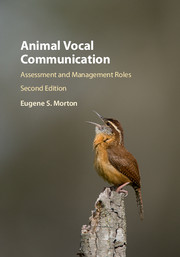Crossref Citations
This Book has been
cited by the following publications. This list is generated based on data provided by Crossref.
Schamberg, Isaac
Wittig, Roman M.
and
Crockford, Catherine
2018.
Call type signals caller goal: a new take on ultimate and proximate influences in vocal production.
Biological Reviews,
Vol. 93,
Issue. 4,
p.
2071.
Hasiniaina, Alida F.
Scheumann, Marina
Rina Evasoa, Mamy
Braud, Diane
Rasoloharijaona, Solofonirina
Randrianambinina, Blanchard
and
Zimmermann, Elke
2018.
High frequency/ultrasonic communication in a critically endangered nocturnal primate, Claire's mouse lemur (Microcebus mamiratra).
American Journal of Primatology,
Vol. 80,
Issue. 6,
Frick, Ramiro
Bich, Leonardo
and
Moreno, Alvaro
2019.
An Organisational Approach to Biological Communication.
Acta Biotheoretica,
Vol. 67,
Issue. 2,
p.
103.
Digweed, Shannon M.
2020.
Encyclopedia of Animal Cognition and Behavior.
p.
1.
Magrath, Robert D.
Haff, Tonya M.
and
Igic, Branislav
2020.
Coding Strategies in Vertebrate Acoustic Communication.
Vol. 7,
Issue. ,
p.
287.
Digweed, Shannon M.
2020.
Encyclopedia of Animal Cognition and Behavior.
p.
1.
Liu, Ying
Zollinger, Sue Anne
and
Brumm, Henrik
2021.
Chronic exposure to urban noise during the vocal learning period does not lead to increased song frequencies in zebra finches.
Behavioral Ecology and Sociobiology,
Vol. 75,
Issue. 1,
Tison, Remi
and
Poirier, Pierre
2021.
Communication as Socially Extended Active Inference: An Ecological Approach to Communicative Behavior.
Ecological Psychology,
Vol. 33,
Issue. 3-4,
p.
197.
Graziano, Michael S. A.
2022.
The origin of smiling, laughing, and crying: The defensive mimic theory.
Evolutionary Human Sciences,
Vol. 4,
Issue. ,
Grieco, Fabrizio
2022.
Pervasive low‐frequency vocal modulation during territorial contests in Eurasian Scops Owls (Otus scops).
Ibis,
Vol. 164,
Issue. 1,
p.
282.
Digweed, Shannon M.
2022.
Encyclopedia of Animal Cognition and Behavior.
p.
6425.
Heckscher, Christopher M.
2022.
Use of simple graded signals in the long-distance vocal communication of a forest thrush (Catharus fuscescens).
Bioacoustics,
Vol. 31,
Issue. 1,
p.
92.
Digweed, Shannon M.
2022.
Encyclopedia of Animal Cognition and Behavior.
p.
5903.
Grieco, Fabrizio
2022.
Vocal behaviour reveals asymmetries in neighbour relationships in a semi-colonial raptor, the Eurasian Scops Owl Otus scops.
Behaviour,
Vol. 160,
Issue. 1,
p.
27.
Zheng, Da‐Jiang
Okobi, Daniel E.
Shu, Ryan
Agrawal, Rania
Smith, Samantha K.
Long, Michael A.
and
Phelps, Steven M.
2022.
Mapping the vocal circuitry of Alston's singing mouse with pseudorabies virus.
Journal of Comparative Neurology,
Vol. 530,
Issue. 12,
p.
2075.
Tison, Remi
2024.
The fanciest sort of intentionality: Active inference, mindshaping and linguistic content.
Philosophical Psychology,
Vol. 37,
Issue. 5,
p.
1017.





